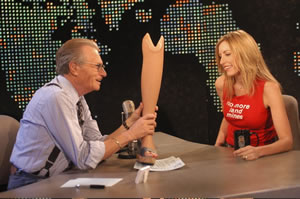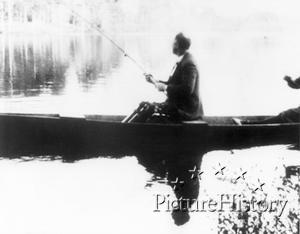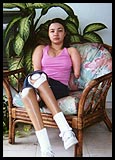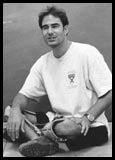 My World, watercolor
and crayon, 121x91cm
My World, watercolor
and crayon, 121x91cm

Aimee
Mullins in The Guardian, August 29th 1998, and September issue of Dazed
and Confused. It was part of a fashion shoot by photographer Nick Knight
for Alexander McQueen, in which a range of disabled people appeared
as models. The large colour photo presents Mullins sittting on the
floor, her head in her hand in a defeated or melancholic
position. She appears squeezed into the frame, contained by the photo’s
borders. The colours of the image are
brown and beige, earthy, taking up the blond of Mullins’ wild hair
and echoed in the make-up. Mullins is wearing
various stiff items of clothing, all of which extend out of the photo
frame. The clothes are referenced in the
accompanying text, in accordance with the generic conventions of fashion
photography. They comprise of: a
calico-coloured skirt skeleton reminiscent of whalebone crinoline underskirts
(crinolin frame, for hire from
Angels and Bermans) and a textured close-fitting top (suede T-Shirt
by Alexander McQueen) to which shoulder
ornaments are attached that look like wooden filigree Japanese or Spanish
fans (wooden fan jacket, by
Givenchy Haute Couture). She is also wearing artificial ‘mannequin’
lower legs (not referenced as ‘model’s
own’ in the picture blurb, but extensively discussed in the Press).
The legs look old and stained, and while one
foot with coloured toenails is visible in the frame, the other reaches
out to frame-left.
The image immediately connotes to me Romantic dolls and artificial ladies
on the borderline of life and death –
Hoffmann’s Olimpia or Eichendorff’s marble Venus (see Hoffmann, 1990
and Eichendorff, 1986). In the Mullins photo, the drained colour scheme,
bedraggled hair, the exotic connotations of the fans and the
historic allusions of the skirt all create this image of a doll, as
does the visible seams between Mullins’ real and
her artificial legs, which look like the joint of Barbie dolls with
bendable knees. Even her ‘real’ flesh looks stiff:
her gaze is fixed, staring downwards, and both her hands, one underneath
her head, one on her knee, are open
with fixed, spread fingers.
The cyborgian quality of Mullins's body as a mixture of the natural
and the artificial is negated by the image of
the doll: here, her body is wholly artificial.



In October 2002, Heather famously removed her artificial limb on Larry
King Live after the veteran talk show host asked her about it. She
said she did it to take the stigma away from disability and to help other
amputees not be embarrassed by their disability. That particular show was
nominated for an Emmy.

 Diagnosed
at the age of 5 with osteonecrosis (a bone disease which, for Shannon,
means bilateral deterioration of tissue cells in the bones of hips), Shannon
dances on crutches, and has developed an extraordinary vocabulary with
impeccable timing, fluidity and body awareness. Spatial Theory includes
a live narrated video segment that that examines his street performance
explorations. With the combined forces of his legs and his crutches, Shannon
is, simply put, a four-legged, hip-hop wonder.
Diagnosed
at the age of 5 with osteonecrosis (a bone disease which, for Shannon,
means bilateral deterioration of tissue cells in the bones of hips), Shannon
dances on crutches, and has developed an extraordinary vocabulary with
impeccable timing, fluidity and body awareness. Spatial Theory includes
a live narrated video segment that that examines his street performance
explorations. With the combined forces of his legs and his crutches, Shannon
is, simply put, a four-legged, hip-hop wonder.
"On a muggy summer afternoon, the physically disabled break-dancer-performance
artist [Bill Shannon] follows in the foot-steps of one of his idols, Charlie
Chaplin, by staging pratfalls in the busy street. Off to the side, a hidden
assistant videotapes the action Candid Camera-style.
"As Shannon, a.k.a Crutchmaster, pops off the end of the rail, an accident
seems inevitable. No one is there to catch him. But just in time, he manages
to right himself in midair before landing gracefully on a pair of crutches,
like an Olympic gymnast completing a perfect routine. Slack-jawed bystanders
stare in amazement. A rotund middle-aged man in shirtsleeves makes the
sign of the cross and leaves."


 1/6 scale figure
1/6 scale figure
In April of 2000, a Call for Entries went out to artists worldwide, asking those who currently have or have ever experienced an orthopaedic condition to submit their work and tell their stories for a themed art exhibit, eMotion Pictures: An Exhibition of Orthopaedics in Art. An orthopaedic condition can be either a disease or condition that affects muscles, bones and/or joints. Arthritis, osteoporosis, scoliosis, spinal cord injury or other spine/back conditions, cerebral palsy, amputation, spina bifida, broken bones, and joint replacement are some examples of orthopaedic conditions.
A similar Call for Entries was issued to orthopaedic surgeons, seeking artwork that illustrates some aspect of the orthopaedic surgeon's feeling about the patient/physician partnership or making a difference in the lives of patients, why he/she became an orthopaedic surgeon, practicing the art of healing, frustration, outcomes, or compassion.
 Hope, Freedom and Peace,
pencil and acrylic paint, 11x14
Hope, Freedom and Peace,
pencil and acrylic paint, 11x14 
 Crooked Bone Tree, acrylic
on canvas, 12x16
Crooked Bone Tree, acrylic
on canvas, 12x16
The figure of the crooked trunk of a young tree first appeared in the 18th century in Book III of Nicholas Andry's L'orthopaedie. His intent was to demonstrate the conforming forces needed to correct the crooked leg of a child. It has since been adopted as the international icon for orthopaedic surgery. This is my interpretation of the symbol.
 Summer Vacation Self
Portrait1998, magic marker, 15x28
Summer Vacation Self
Portrait1998, magic marker, 15x28
Seven-year old was playing barefoot football in his neighborhood in Alabama when he was tackled by his brother. Dr. Steven Barrington, an orthopaedic surgeon and Jonathan's father, took x-rays and discovered he had broken 3 bones in his foot. " I had to spend the rest of my summer on crutches. Even when our family went to the beach before school started,"
 A Surgeon's Eyes, watercolor,
15x28
A Surgeon's Eyes, watercolor,
15x28
A Surgeon's Eyes is a self-portrait that focuses on the non-verbal communication between physician and patient. It depicts a surgeon, prepared for surgery, but focused on the viewer
 My World, watercolor
and crayon, 121x91cm
My World, watercolor
and crayon, 121x91cm
I really hope people in my world could be that close to me. And I wish I would make lots of friends one day.
 Forward Motion,
Mild Steel with Copper Patina, 96x48x12
Forward Motion,
Mild Steel with Copper Patina, 96x48x12
It was inspired by the drive and spirit that we all have to help
improve patient care and fight musculoskeletal diseases. The piercing lines
indicating the direction of movement illustrates advancement of science
represented in art.
 Harmony, mild steel
with copper patina, 54x12x19
Harmony, mild steel
with copper patina, 54x12x19
This piece was inspired by a patient Dr. Benevenia treated after her breast cancer spread to her bones. He performed a hip replacement to restore her ability to walk, and her gratitude was beyond measure. The lines of this sculpture are meant to represent an almost musical, soothing flow; a harmony with the human nature and spirit.
 Foot, Acrylic on Canvas,
24x20
Foot, Acrylic on Canvas,
24x20
The foot is the foundation of the body. It represents the strength,
balance, coordination and aesthetic beauty that make motion possible. The
beauty of the foot is in its form and function; the beauty of this painting
is that depicts the emotion of the foot in motion.
 Clover's Hips, Acrylic
on Canvas, 18x15
Clover's Hips, Acrylic
on Canvas, 18x15
Mrs. Clover Gloriande dealt for many years with degenerative arthritis of both hips, and Dr. Berger performed total hip arthroplasties on her with excellent results.
 Self Portrait
(Diptych), acrylic on canvas, 74x24
Self Portrait
(Diptych), acrylic on canvas, 74x24
Being a person with a disability is an integral part of my life and identity. Without any emotional charge, I am looking steadily in a mirror. I am also gazing back at the viewer of the painting, mildly curious about you.
 Structure, acrylic
on canvas, 40x48
Structure, acrylic
on canvas, 40x48
...optimistic, but a recognition of polio... Making this series of paintings was an emotional release. I am now more accepting of myself as a handicapped person
 Gregory Burns
Gregory Burns Duet, oil on linen,
54x68
Duet, oil on linen,
54x68
...illustrates the feeling of reaching and stretching towards the
wall or goal for which one is swimming or striving for.